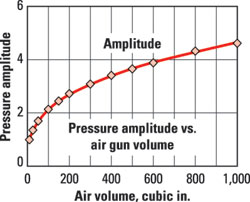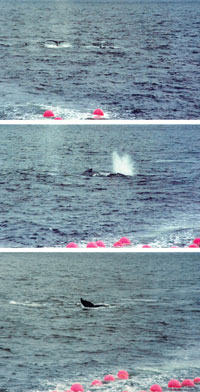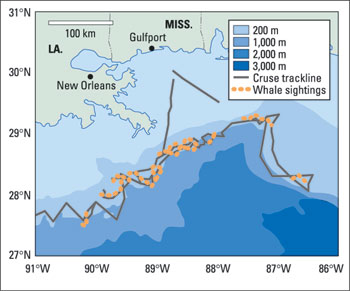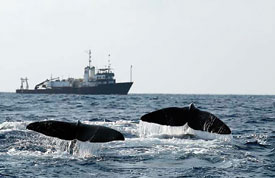Marine mammals and seismic vessels jockey for position
Protecting the EnvironmentMarine mammals and seismic vessels jockey for positionNew and rapidly evolving regulations regarding marine mammals in the Gulf of Mexico and the North Sea may seriously affect seismic operations and costsPhil Fontana, Veritas DGS, Houston, and Chip Gill, Int'l. Association of Geophysical Contractors There is concern worldwide about how the seismic survey industry might impact the health and behavior of marine mammals. The industry has been expecting new regulations in the Gulf of Mexico (GOM) by Mineral Management Service (MMS) and in the North Sea by the Joint Nature Conservation Committee (JNCC). It is in the interest of every lease operator / holder and seismic contractor to keep informed of and participate in the formulation of these rapidly changing regulations, for they are the ones who will ultimately have to pay for them. This article gives the status of new and proposed regulations and how they might affect the way seismic data gathering operations are conducted. It also provides a background on the science surrounding the issues of sound mitigation for the purpose of minimizing the disturbance of marine mammals. GOM STATUS Before July 2002, conducting a large, multi-client seismic-data acquisition program in the GOM required a simple permit application to be filed with MMS. These were generally approved within weeks, if not days. When operating on a lease or exploration unit, the contractor operates as an agent of the operator or leaseholder, and was not required to seek a permit. On July 18th, 2002, all of that changed. As part of the MMS’ Final Notice of Sale 184, for the first time, MMS included a protected species Stipulation to apply to all Sale 184 leases (Western Gulf of Mexico). This Stipulation requires that: all seismic surveys employ mandatory mitigation measures to reduce the potential “taking” (via harassment, not killing) of federally protected species, particularly sperm whales; the area be visually scanned for the presence of sperm whales; an area around seismic airgun arrays be defined as an Exclusion Zone and be visually clear of sperm whales before initiating ramp-up (increasing airgun amplitude) procedures. When visually impaired (nighttime, fog, etc.), operations cannot commence. The sperm whale is protected by both the Marine Mammal Protection Act (MMPA) and listed as an endangered species under the Endangered Species Act. Since MMS's last Programmatic Environmental Assessment (EA), which addressed this issue in 1986, 3D seismic data acquisitions have increased dramatically, while expanding activities into much deeper waters. Knowledge of marine life, particularly the effects of acoustic emissions on marine mammals, has grown. In 1999, MMS commissioned an update of the EA to consider the current body of knowledge in this area. For some time, contractors have expected completion of the EA and have anticipated that MMS would issue interim guidelines under which they would temporarily operate (presumably including mitigation measures), as well as simultaneously beginning a rule-making process and rewriting section 30 CFR 251 rules under which the seismic industry operates. The new rules are expected to codify whatever mitigation measures are called for in the EA. Unexpected was NOAA Fisheries’ issuance of a Biological Opinion as part of their Endangered Species Act consultation with MMS for Sale 184. The Biological Opinion, delivered to MMS just before the Final Notice of Lease Sale was issued for Sale 184, was detrimental to seismic operations. From industry's perspective it was obvious NOAA Fisheries repeatedly mischaracterized seismic operations and acoustic emissions, and it went downhill from there. Ultimately, it included non-discretionary terms and conditions imposed on MMS that led to the Stipulation. Gulf-wide restrictions. The Stipulation itself – only two sentences long – left a lot of details unanswered. As MMS considered the entire matter, they concluded, in light of the new Biological Opinion, that the Stipulation must apply not only to those leases issued in Sale 184, but Gulf-wide. To accomplish this, they issued a Notice to Lessees (NTL), which Regional Director Chris Oynes presented to IAGC with the first NTL draft on August 9th. This first draft led contractors to conclude that, if not amended, it would cause the cost of seismic data acquisition in the GOM to at least double. Fortunately, Mr. Oynes and his staff were very interested in understanding how this draft would impact seismic operations and, along with NOAA Fisheries, were willing to consider changes that would minimize its impact. After extensive discussion and deliberation, MMS issued the final NTL on August 14, 2002. While operators and contractors continue to object to scientific flaws in the Biological Opinion driving the process, the final NTL is generally acceptable to geophysical contractors, although it will still increase the cost of seismic data acquisition in the Gulf. Just the beginning. Contractors appreciate the consideration MMS gave to their perspective in developing the August 14th NTL and recognize that it is only the beginning of a long process. A big concern is the likelihood of “regulatory creep,” but it is looking like this episode was “regulatory sprint.” NOAA Fisheries is writing a new Biological Opinion for the upcoming multi-sale Environmental Impact Statement (years 2003-2005) for the Central and Western Gulf of Mexico; it will replace the current Biological Opinion. This is an opportunity to seek improvement in some of the misunderstandings contained in the existing Opinion. NOAA Fisheries also intends to commence a formal rule-making under the MMPA to enable them to issue Letters of Authorization for Incidental Takes associated with geophysical operations. Concurrently, the EA will be finalized by MMS in the near future. Interim guidelines and a Gulf-wide rule-making process will commence. The potential impacts of those regulatory events are huge. NORTH SEA REGULATION In UK waters, existing protection derives from a slew of regulations and agreements. For example, the UK is a signatory to the Agreement on the Conservation of Small Cetaceans of the Baltic and North Seas and has applied its provisions in all UK waters. Among other actions required to conserve and manage small cetaceans (cetaceans are mostly marine mammals including whales, dolphins, porpoises and related forms), the Agreement requires range states to “work toward...the prevention of ...disturbance, especially of an acoustic nature.” The UK's requirements are similar, but not identical, to those in the GOM and are summarized here, with comments. Look and listen. At least 30 min. before using any seismic source, operators and observers should carefully look from a high observation platform for marine mammals within 1,600 ft. Hydrophones and other listening equipment may provide additional information on the presence of inconspicuous species, such as harbor porpoises or submerged animals, and should be used in particularly sensitive areas. Delay. If marine mammals are present, startup of seismic sources should be delayed until they have moved away, allowing at least 20 min. after the last sighting to let the animals move well out of range. The soft start. Except for sensitive areas, all seismic surveys using a source size of more than 180 cu in. must follow a soft-start procedure. Otherwise, every time airguns are used – including before test firing and regardless of whether marine mammals have been seen – acoustic power should be built up slowly. Methods include starting with the smallest airgun in the array, and gradually adding in others, and/or ramping up air pressure for at least 20 min., but not longer than 40 min. If for any reason, shooting stops for at least 5 min., a visual check should be made for marine mammals within 1,600 ft and a 20-min. soft start must be carried out. While this should not be a problem during normal streamer operations and turnarounds, line-change times during site surveys and OBC/OBS surveys are usually less than 20 min. In fact, source-vessel line-change times for OBS surveys are a critical factor in the overall economic planning of a project. Any systematic increase beyond the planned line-change time can have a substantial negative impact on survey economics. A similar economic negative could occur with VSP surveys. The major financial consideration for a VSP survey is rig time while the downhole seismic tool is run. VSP surveys are designed to minimize the time it takes to move the sensor array from level to level. Once the sensor array has been repositioned and is ready to record, the source must be ready to fire. Report after the survey. An extensive written report will be submitted upon completion of the survey. Marine Mammal Observers (MMOs). MMOs must attend a short course on implementing the guidelines and recording procedure. For sensitive marine areas, the MMO must also be an experienced cetacean biologist or similar. The MMO should be employed solely for the purpose of minimizing disturbances to marine mammals during seismic surveying. In UK waters, all surveys that require MMOs which take place between April 1st and November 1st north of 57 latitude will require two dedicated MMOs due to longer daylight hours. Using a second crewmember with other onboard responsibilities is not considered an adequate substitute for a dedicated MMO. Operators are advised to contact JNCC at the earliest opportunity to request information on the need for MMOs. Every application for consent to carry out a seismic survey will be treated on a case-by-case basis by the JNCC. The requirement for third-party MMOs is probably the most difficult issue for seismic contractors. Drawing on experience thus far, they have doubts about the effectiveness of MMOs. In some cases, MMOs were ex fishermen – experienced at looking at the sea and knowing what it told them. In other cases, the observer would not know what a whale at sea looks like. Contractors feel that a better solution would be to train existing crewmembers, eliminating a space problem and, more important, an additional HSE risk. This means that, in addition to training in cetacean observation and reporting, MMOs must also be trained to respond to offshore emergencies as part of a team – not a trivial task. Visitors and/or third-party personnel that are not part of the crew are a safety liability. Therefore, this function could be more efficiently performed by existing crewmembers. The IAGC believes that mitigation guidelines should be species-specific. There is ample evidence that hearing sensitivities of various marine mammal species is frequency dependent. For example, most toothed whales do not have acute hearing sensitivity at frequencies below 500 Hz, while most baleen whales do. The main acoustic energy generated by an airgun array resides at frequencies well below 500 Hz. Therefore, the potential “impact” zone should be different for toothed whales vs. baleen whales. Acoustic monitoring. Hydrophones are a useful aid to detecting cetaceans. Cetaceans communicate with each other using whistles, creaks, chirps and moans which may be heard over considerable distances. Trains of clicks are used for echolocation and foraging. JNCC, MMS and IAGC concur that industry should continue to research and develop the use of hydrophones for cetacean monitoring, especially in sensitive waters. It would be particularly useful if acoustic systems were able to detect cryptic and deep-diving species such as sperm whales, beaked whales and baleen whales. In areas that are frequented by small cetaceans, hydrophones should be capable of receiving the high-frequency sounds used by these animals. JNCC envisions that, as acoustic monitoring systems develop over the next two to four years, their use in sensitive areas will become an integral part of these guidelines, along with existing visual observations from MMOs. Contractors support this emerging technology, but feel that it is presently an experimental science. To be viable, acoustic monitoring systems should have the following characteristics:
Current systems are capable of detecting vocalizing submerged animals and estimating ranges based on assumptions of animal vocalization source levels. These estimates have a wide range of error. Species discrimination seems to be a function of the “ear” of the operator. But this is a rapidly evolving technology, so the near future may bring better solutions. The IAGC considers the development and evaluation of marine mammal acoustic detection and tracking technology to be a high priority research topic. IAGC intends to actively sponsor tests of available and emerging technologies. SOUND SCIENCE To provide a soft start to the various airgun sources (i.e., exploration, site surveys and VSPs), it is suggested that airgun arrays be classified by the number of elements that make up the array (single guns and clusters are considered individual elements). The output from an individual airgun is proportional to the cube root of the volume of air contained in the airgun. In practical terms, this relationship means that the airgun volume would have to be increased by a factor of 8 to double the acoustic amplitude: cube root of 8 = 2. As can be seen in Fig. 1, doubling the output of a 100 in3 airgun requires an 800 in3 airgun.
However, if only 400 in3 of high-pressure air is distributed between four 100 in3 airguns, more than twice the acoustic output would be produced compared to a single 800 in3 airgun. In other words, there is twice the output from only half the volume. Therefore, the output-sound pressure level for an airgun array is more closely related to the total number of elements in the array than to the total array volume. For “deep” seismic exploration sources, the typical number of array elements ranges from about 16 to 32, depending on the geophysical objectives. If the soft-start procedure is written so that the signal output is incremented by a factor of two (i.e., 6 dB) in 5-min. increments, and it is agreed that the nominal maximum array contains about 32 elements, then a sliding scale can be applied to any airgun array. This type of guideline can be applied equally to airgun arrays used for VSP, site surveys, scientific investigations and exploration seismic surveys. For site survey and VSP arrays that use gun controllers that do not allow control of the firing of individual guns, an alternative approach to a soft start may be accomplished by gradually increasing the air pressure from, say, 500 to 2,000 psi, in 500-psi increments. Point source response. For regulatory purposes, the pressure signal produced by an airgun array is treated as if it came from a single airgun, i.e., a point source. However, in practice, the airguns are distributed in an array, so the seismic source is not a point source. Nevertheless, the seismic industry generally reports the pressure signature amplitude in units of bars at 1 m, or bar-m, although there is no real position in the water where pressure of that magnitude is experienced. Thus, no animal could possibly be exposed to the pressure levels quoted at 1 m from the theoretical point source. A point-source response is a convenience that only has validity in the far-field, which is a distance from the array where the acoustic output appears to be coming from a point source, say, about 500 ft, depending on source strength and geometry. Since the far-field distance is frequency dependent, the point-source model produces pressure values that over-estimate the real values in the near-field vicinity of the array. The higher the frequency, the higher the over-estimate of acoustic pressure – in some cases as much as 100 times. Finally, airgun arrays are designed to concentrate energy in a 20 vertical cone by “gathering” frequencies via constructive and destructive interference. Seismic vessels move at about 2 – 2.5 knots, firing airguns roughly every 10 to 15 sec. This means that marine mammals horizontal to the airgun array will receive “defocused” sound of much lower amplitude. And a mammal swimming beneath the vessel at a range of 300 ft would only receive one or two exposures of meaningful intensity before the vessel had passed, unless, of course, the animal moved along with the vessel. Cetacean auditory systems. By examining the characteristics of seismic signals with respect to cetacean auditory systems, it can be argued that there is almost no risk that seismic signals can cause physical damage to the hearing of any species of marine mammals. The consensus of the data is that virtually all marine-mammal species are potentially impacted by sound sources with a frequency above 500 Hz. However, relatively few species are likely to receive significant impact from frequencies well below 500 Hz, which is where the main energy from airgun arrays resides. The two most likely candidates affected at these lower frequencies are baleen whales and the elephant seal (Ketten, 1998). As for negative behavioral changes, studies as to cause and effect from seismic “noise” have been inclusive; available research is replete with conflicting results. There is much anecdotal evidence from seismic survey crews of dolphins, seals, and whales approaching an active seismic source and staying in the vicinity for some time, Fig. 2. Behavioral response remains an area requiring further research.
SWSS In the summer of 2002, MMS, the Office of Naval Research, Texas A&M Research Foundation (TAMRF) and IAGC participated in the Sperm Whale Seismic Study in the GOM. As recently as the mid-1980s, sperm whales were not generally known to inhabit the Gulf of Mexico – they were not even mentioned in the 1986 Environmental Assessment. But they are now widely known to populate the Gulf of Mexico in large numbers and to concentrate along the 1,000-m water-depth contour, Fig 3. They spend most of their life feeding under water, diving to 1,500 to 5,000-ft depths, echo-locating their prey (6-ft squid) and staying submerged for 40 min. to more than an hour and a half at a time. It is this localized, deep-diving nature that has gained the attention of regulators.
Two SWSS cruises took place in June through August 2002. Two main tasks of these cruises included deploying satellite-tracking tags (for surface movements, good for nine months) and digital tags (for subsurface tracking, good for nine hours) on sperm whales. Other goals included: surveying for sperm whales by visual and acoustic means; photographing sperm-whale flukes for future identification; and recording surface behavior, especially in response to seismic sources. These cruises saw remarkable success. Eighteen satellite tags and 19 digital tags were placed on sperm whales. DNA samples were obtained from 16 of the tagged whales along with photographs of their flukes, Fig. 4. High quality photo-ID images were obtained of 32 different sperm whales. Both cruises employed the TAMRF vessel, while the second cruise added the IAGC-sponsored vessel, Rylan T., equipped with seismic airguns from Fairfield Industries. An important aspect of the cruise was testing the behavioral response and measuring received sound levels for digitally-tagged sperm whales exposed to controlled approaches by the Rylan T.
SWSS results will be used by MMS to evaluate the potential effects seismic surveys may have on sperm whales, whether some areas of the Gulf are preferred by these whales, and what actions would mitigate adverse effects, if any. Initial results of these cruises will be presented at the MMS Information Transfer Meeting in New Orleans in January 2003, with a final report on all matters by TAMRF scheduled in early 2005. CONCLUSION The future form of the regulatory structure, when it will be in place nor the effect on the E&P industry is not predictable. However, it is certain that big changes will occur in the near future. The industry is at the beginning of a long process that will not only effect seismic data acquisition, but also near-surface (geo-hazard) surveys, downhole seismic surveys, platform removals, and probably even crew and supply-boat operations. Geophysical contractors, through IAGC, have been and will continue to be engaged in policy deliberations that will result in regulatory changes. IAGC will also work closely with the E&P community in these matters, since it is in the interest of every lease operator / holder to keep abreast of these rapidly changing regulations.
|
|||||||||||||||||||||
- Prices and governmental policies combine to stymie Canadian upstream growth (February 2024)
- U.S. producing gas wells increase despite low prices (February 2024)
- U.S. drilling: More of the same expected (February 2024)
- U.S. oil and natural gas production hits record highs (February 2024)
- Quantum computing and subsurface prediction (January 2024)
- U.S. upstream muddles along, with an eye toward 2024 (September 2023)






